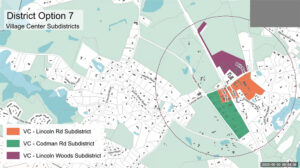
Option 7 for rezoning Lincoln to comply with the Housing Choice Act. Not shown is a fifth subdistrict encompassing the Lincoln North office park. (Click image to enlarge).
To comply with the Housing Choice Act, town officials are considering a new multifamily zoning district in addition to those that were previously examined after consultants refocused on the village center in response to feedback at two public forums on June 16 and June 20.
The HCA requires Lincoln to approve new zoning that would allow at least 15 multifamily housing units per acre and a total of 635 units on a total of 42 acres. The final district can include several subdistricts in various locations as long as several requirements are met (i.e., one of the subdistricts must account for at least half of the district’s total land area, 20% of the land must be within half a mile of the commuter rail station, all the land targeted must be developable, and existing properties may not be divided into more than one new zone).
Five initial subdistricts were presented on June 6. Two combinations of those subdistricts met all state requirements. Both included several South Lincoln parcels around the intersection of the railroad tracks and Lincoln Road. One of them also included a 39-acre Battle Road Farm/Lincoln North/MinuteMan parcel, while the other included a 37-acre Commons of Lincoln/Oriole Landing segment instead.
Two new options discussed at the Housing Choice Act Working Group meeting on June 30 (video here) include subdistricts of various shapes in the South Lincoln village area as well as some land in North Lincoln. One variation, Option 6, probably isn’t viable because it’s uncomfortably close to the minimum HCA requirements around wetlands and other exclusions. “This is sort of a precarious version, threading the needle a little too much,” said Zoë Mueller, an urban planner with consulting firm Utile.
Option 7, which Utile is recommending to the town, includes:
- Lincoln Woods, which now has 125 units but would be allowed to have up to 159.
- A Lincoln Road subdistrict encompassing both sides of Lewis Street east to Ryan Estate and 136 Lincoln Rd., including the first rectangular Ridge Road condo building but not the “flying nuns”.
- A Codman Road subdistrict bounded by Codman Road to the west, Lincoln Road to the north, the railroad tracks to the east, and 108 Codman Rd. to the south. The DPW site is inside that subdistrict but can’t be included in the housing calculation.
- The Lincoln North office park property, but not Battle Road Farm or other parcels in the area.
None of the proposals that have been discussed include the Lincoln Mall because the HCA says that towns can’t require multifamily housing in commercial districts. In a separate plan, the town hopes to redevelop the mall in partnership with Civico Inc. to as a three-story building with businesses on the ground floor and residences on the two floors above. That rezoning proposal, which may also end up including the Doherty’s Garage property, will require separate voter approval at Town Meeting.
Option 7 “very comfortably” meets state guidelines, Mueller said. “This was a really good outcome, I think, responding to a lot of the feedback that was provided.”
Some of the earlier ideas would have allowed significantly more total units that the HCA requires, so some of the feedback included questions about “whether we could get closer to what our [minimum] target was,” said Select Board member Jennifer Glass. Others wondered why the proposals included so much land around Oriole Landing and North Lincoln. There is an MBTA bus stop in North Lincoln but the train is far more heavily used by commuters and others, which the HCA aims to encourage.
If approved at Town Meeting in March 2024, the rezoning would allow affected property owners to build (or sell to a developer to build) denser housing on their land, but no one would be required to sell. Construction on the site of an existing condominium development would require approval or sale by every condo owner. Any multifamily development would also be constrained by septic and parking requirements.
Kudos to the Working Group for artfully “threading the needle” on creation of subdistricts.
That said, we should be more cautious in the issue of language-there is NO requirement that we do this. This is NO mandate. The compliance provides access to grants that it is not yet clear Lincoln would ever seek, as we have not seen these grants relevanat to us, in the past.
So, please, will all avoid the use of terms that mispresent what the HCA is all about.
It is the “Housing CHOICE Act.”
I wonder where the additional 29 units would go at Lincoln Woods. The septic system is dysfunctional, the existing structures are old. Would adding additional units put a burden on the septic system? I’d like the see the whole Lincoln Woods development torn down and built back from the ground with the ground floor of all units wheelchair accessible. There are cracks between walls and door frames. There is mold due to the development abutting a swamp. The mold has been accumulating in the walls and ceilings since the 70s. I undersrand this is all probably at the discretion of The Community Builders and not the Town but the Town should be aware of the issues before recommending simply adding units to an existing development.